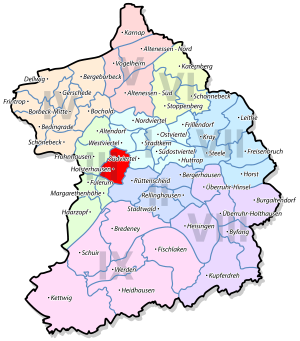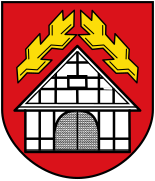Holsterhausen (Essen)
|
Holsterhausen |
|

|
|
| Basic data | |
|---|---|
| surface | 2.98 km² |
| Residents | 26,466 (March 31, 2020) |
| Coordinates | 51 ° 26 '27 " N , 6 ° 59' 43" E |
| height | 108 m |
| Incorporation | Aug 1, 1901 |
| Spatial assignment | |
| Post Code | 45145, 45147 |
| District number | 09 |
| district | District III Essen-West |
| image | |
|
View of Holsterhausen from the south, below the university hospital |
|
| Source: City of Essen statistics | |
Holsterhausen is a district of the independent city of Essen , the fourth largest in terms of inhabitants. Holsterhausen is located southwest of the city center between the districts of Rüttenscheid , Margarethenhöhe , Frohnhausen , West and Südviertel .
history
The name goes back to the former location of the district directly on the forest, hence "those who lived on the wood (at the forest)". Holsterhausen was first mentioned in a document in 966, when Emperor Otto I donated the Ehrenzell court , the core of the so-called three - tenant quarter , to the convent of the Essen monastery. The three peasantry quarters consisted of the three later Essenes districts Altendorf , Frohnhausen and Holsterhausen and was after the secularization of the municipality Borbeck allocated. In 1874 the mayor's office Altendorf was formed, to which Altendorf, Frohnhausen and Holsterhausen belonged. Its existence ended with the incorporation into the city of Essen on August 1st, 1901. Due to its central location and the proximity to the Krupp works, Holsterhausen was so badly destroyed in the Second World War that after the war it was the largest contiguous rebuilding area in West Germany .
coat of arms
Blazon : “In red a silver (white) house with black half-timbering and gate; A golden (yellow) trunk with stub branches above the gable in front and behind. "
The coat of arms was designed by Kurt Schweder and never had an official character. At the end of the 1980s, the heraldist created coats of arms for all of Essen's districts. They have meanwhile been well received by the Essen population.
The coat of arms is a so-called " talking coat of arms "; the trunks allude to the residence of the "Holzseter" (holster) or forest workers. The house stands for the ending "-hausen".
character
Holsterhausen is predominantly residential area, on the periphery there are a few larger green spaces such as the Mühlbachtal or industrial areas such as the Schederhofviertel in the north. Due to its location between the center of Essen and the outer districts of the city, Holsterhausen has a dense road network and is criss-crossed by several main roads that are connected to the A 40 that runs through the district . In addition, several bus, light rail and two subway lines operate at regular intervals in Essen . The traffic load is correspondingly high. The district's shopping street is Gemarkenstraße, the center of which is the Church of St. Mary's Conception . An afternoon market is held on this street on Thursdays.
The secondary schools in Bardelebenstraße are the historically important Catholic girls ' high school BMV and in Margaretenstraße the Alfred-Krupp-Gymnasium , which was built as a secondary school in 1908 and was named Krupp-Oberrealschule in 1910. It was a concession of Essen in the incorporation contract of the mayor's office Altendorf from 1901. In 1937 the school was renamed the Alfred Krupp School. Since the 1960s, girls have also been admitted to the boys’s grammar school, which is later to be used for mathematics and science. The Holsterhausen comprehensive school is also located on Holsterhauser Platz and Keplerstrasse.
The University Hospital Essen (formerly the municipal hospitals) is located in Holsterhausen . Despite the dense development, there are some green areas in Holsterhausen, such as part of the Haumann Park in the justice district and some children's playgrounds. Parts of former workers' settlements , such as the Alfredshof , which have been modernized according to the needs of today's residents without losing their character, are still reminiscent of the industrial era of Krupp .
Germany's oldest existing petrol station is located in the back yard of the house at Gemarkenstrasse 18.
On January 9, 1964, the Essen Youth Center (JZE) was opened on Papestrasse. Built for four million DM , it was a gift from the city of Essen to the youth. On June 1, 2011 the center was closed.
Radio tower on the A40
Part of the Alfredshof settlement
University hospital main entrance
population
On March 31, 2020, there were 26,466 residents in Holsterhausen.
Structural data of the population in Holsterhausen (as of March 31, 2020):
- Share of the population under 18 years of age: 12.9% (Essen average: 16.2%)
- Population of at least 65 year olds: 17.2% (Essen average: 21.5%)
- Proportion of foreigners: 19.9% (Essen average: 16.9%)
Sons and daughters
- Henry Wickenburg (1819–1905), born in Holsterhausen as Johannes Henricus Wickenburg, emigrated to the USA in 1847. The city of Wickenburg in Arizona is named after him
- Walter Sartorius (1875–1937), architect
- Paul Vogt (1926–2017), art historian
literature
- Karl-Josef Gierlichs / Ludger Kruthoff / Claudia Rademacher-Gottwald: Parish Church of St. Ignatius, Essen-Holsterhausen . Fink Verlag, Lindenberg 2003, ISBN 978-3-89870-097-9 .
- Norbert Küpper: Holsterhausen. People and their stories . Klartext Verlag, Essen 2011, ISBN 978-3-8375-0659-4 .
- Norbert Küpper / Klaus Lindemann: My Holsterhausen. Time and space in an Essen district . Klartext Verlag, Essen 2010, ISBN 978-3-8375-0166-7 .
Web links
- Holsterhauser Bürgerbund eV
- Brief portrait of the district on the homepage of the city of Essen
See also
Individual evidence
- ↑ See also Johann Rainer Busch: Kurt Schweders Wappen der Essener Stadtteile Essen 2009, p. 60
- ^ WAZ media group: Big farewell party for the closing youth center in Essen; May 15, 2011
- ↑ Population figures of the districts
- ↑ Proportion of the population under 18 years of age
- ↑ Proportion of the population aged 65 and over
- ↑ Proportion of foreigners in the city districts










